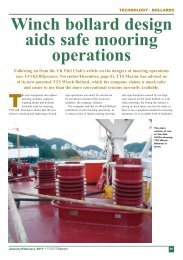Create successful ePaper yourself
Turn your PDF publications into a flip-book with our unique Google optimized e-Paper software.
SHIPBOARD<br />
HANDLING<br />
EXCELLENCE<br />
www.ttsgroup.com<br />
<strong>Slewing</strong> <strong>ramps</strong><br />
The <strong>TTS</strong> wire-operated slewing ramp offers considerable advantages in cargo access.<br />
Its main benefit is that it will allow the vessel to berth in the normal manner aft or<br />
alongside a quay without the need for dedicated shore facilities. The slewing can be of<br />
one or two side slewing, starboard mid and portside.<br />
<strong>MARINE</strong>
SLEWING RAMPS<br />
Heavy loads can be<br />
accommodated over the <strong>TTS</strong><br />
slewing ramp, whose operating<br />
system can be designed to<br />
absorb most of the weight of the<br />
ramp, thus keeping the pressure<br />
on the quay to quite low levels<br />
and avoiding any damage to<br />
its surface. As no specifically<br />
strengthened quay areas are<br />
required, ships equipped with<br />
a slewing ramp can operate at<br />
virtually any port, giving full<br />
flexibility of route.<br />
<strong>TTS</strong> wire-operated slewing<br />
<strong>ramps</strong> are arranged in three<br />
sections plus the turntable<br />
section and can cater for a<br />
range of quay heights above<br />
and below the deck attachment<br />
datum point. The three sections<br />
are designed so that in normal<br />
working conditions the slope<br />
will not exceed 1:8 (7.1 deg) but<br />
in extreme conditions the slope<br />
limit can be increased to 1:6 (9.5<br />
deg). The <strong>ramps</strong> can be designed<br />
and built in all sizes and, where<br />
required, slewing units operated<br />
by the main winches or by<br />
direct hydraulic cylinders in the<br />
turntable can also be supplied.<br />
The ramp is of open<br />
construction between two<br />
longitudinal girders, one on each<br />
side. Hydraulically-operated<br />
buttressing cylinders are located<br />
between the inner and outer<br />
sections, at the longitudinal side<br />
girders, and act as adjustable<br />
buttresses to accommodate the<br />
adjustments necessary for the<br />
different quay heights.<br />
The outer, third section of the<br />
ramp incorporates flaps for the<br />
transition between ramp and<br />
quay, and the whole structure is<br />
designed with in-built mechanical<br />
flexibility. This ensures that the<br />
whole of the outer section will<br />
rest on the quay even with the<br />
ramp empty and the ship listing<br />
approx. ±3 deg.<br />
The operating winches may<br />
be set in self-tensioning mode<br />
in which they automatically<br />
maintain the tension on the wires<br />
and thereby control the pressure<br />
of the ramp on the quay.<br />
Deployment of the ramp takes<br />
15–30 minutes depending on<br />
its size.<br />
Ramp shown slewed to<br />
starboard. Ramp can also be<br />
slewed to port side<br />
www.ttsgroup.com


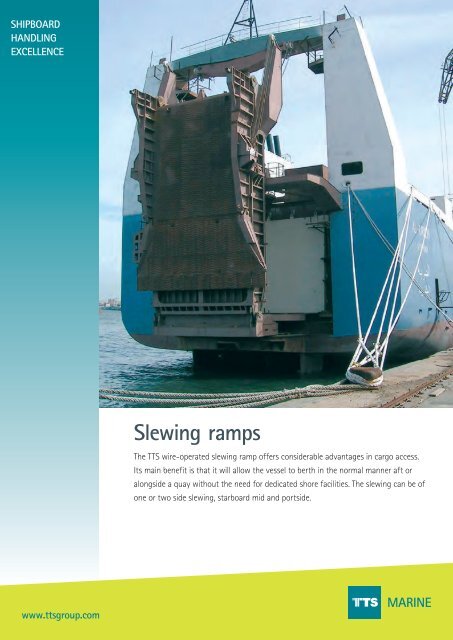


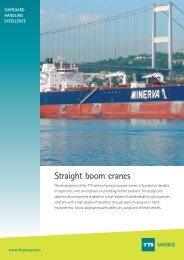

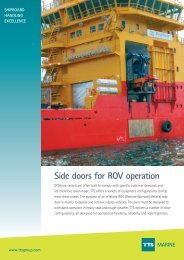
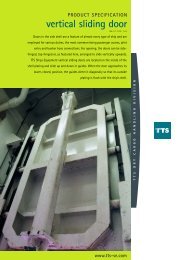
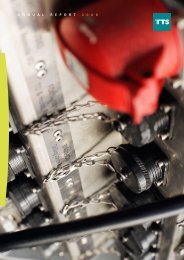


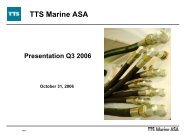
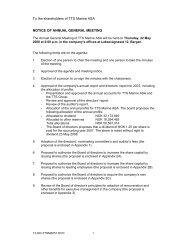
![2012.MasterPresentation_final [Compatibility Mode] - TTS Group ASA](https://img.yumpu.com/4612021/1/190x146/2012masterpresentation-final-compatibility-mode-tts-group-asa.jpg?quality=85)


